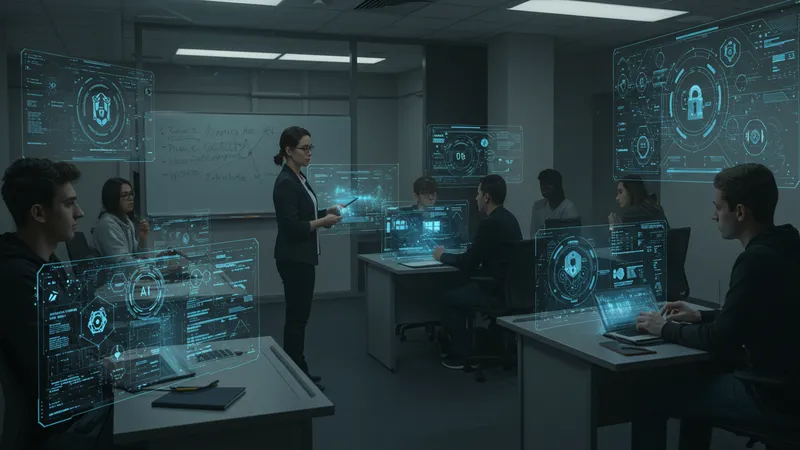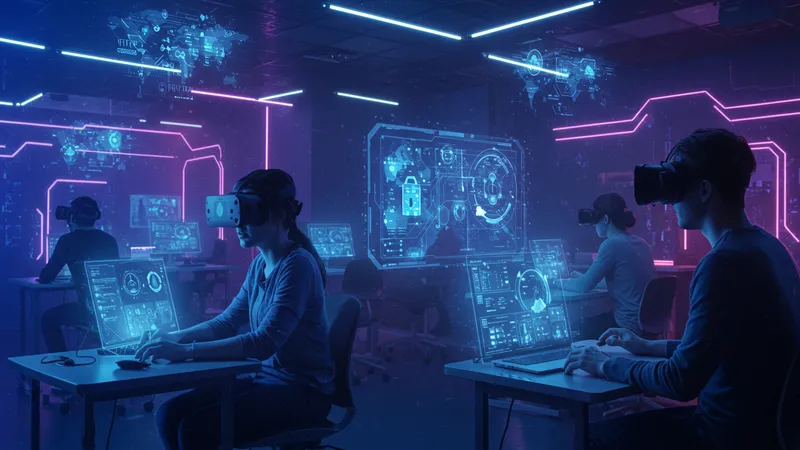

Did you know that most cybersecurity degree holders struggle to land relevant jobs? That's because a shocking disconnect exists between academic focus and job market demands.
In an era of rampant cyber threats, understanding this misalignment is pivotal. The stakes have never been higher—with companies losing billions to cyberattacks annually.

Despite billions invested in cybersecurity education, graduates often find themselves unprepared for industry challenges. Traditional curriculums emphasize theoretical knowledge but lag in cutting-edge practices. Shockingly, only 15% of graduates feel confident with real-world skills upon entering the workforce. But that’s not even the wildest part...
Employers are frustrated. They're looking for candidates with hands-on experience, yet many degree programs are stuck in the past. In a survey, 90% of recruiters expressed concerns over the suitability of job applicants from such backgrounds. However, there’s an emerging educational shift that promises to change everything. What happens next shocked even the experts…
Many cybersecurity programs still teach outdated programming languages and systems that are no longer relevant. While foundational knowledge is crucial, the lack of instruction in modern tools like Python and AWS is a significant gap. This gap leaves graduates scrambling to catch up when they start their first job. But there’s one more twist...

Furthermore, internships and co-op placements are scarce in many programs, depriving students of real-world experience. Students often learn about hacking in a neat and tidy academic setting rather than understanding the messiness of actual cyber threats. Employers, however, demand practical knowledge and problem-solving skills. What you read next might change how you see this forever.
Interestingly, some forward-thinking universities are starting to partner with tech companies to revamp their curriculums. They're introducing courses that emphasize industry collaboration, making students more job-ready. This trend, although nascent, is gaining traction and could redefine the landscape of cybersecurity education.
Such partnerships highlight a burgeoning shift where academia finally begins to mirror the realities of the industry. However, integrating these changes on a larger scale remains a challenge. What lies ahead could redefine the boundaries of cybersecurity education forever.
Cybersecurity degree programs are not only misaligned with market needs but are often prohibitively expensive. The average cost of a four-year degree in cybersecurity can exceed $100,000. Graduates frequently end up with hefty loans, which takes years to pay off, often hampering their financial well-being. Yet, the skills acquired may not guarantee a high-paying job immediately.

Moreover, tuition costs are rising faster than inflation, raising questions about the return on investment. Considering that technological knowledge evolves rapidly, the time it takes to complete a degree might render some acquired skills obsolete. Students thus find themselves paying for an outdated education—the irony is staggering.
In some instances, bootcamps or specialized certifications offer a more cost-effective alternative. These programs are shorter, more focused, and constantly updated to reflect industry trends. This ensures that graduates leave with relevant skills. But how do they compare in terms of long-term benefits?
The conversation around the financial sustainability of traditional degrees versus alternative learning paths continues to grow. As more students seek education options that provide both cost efficiency and market relevance, the traditional university model faces intense scrutiny. The ripple effects could alter the future of higher education in unexpected ways.
Cybersecurity certifications have exploded in popularity as a quick-fix solution to traditional degree shortcomings. They promise to deliver specialized skills in a fraction of the time. Yet, questions loom about their thoroughness: Do certifications impart in-depth knowledge or just surface-level competencies?

While many certifications, like the CISSP and CEH, are acknowledged by employers, they often focus on specific areas. They may lack the broad foundation that a degree could provide. This has sparked debates over whether these programs are complementary or substitutive to conventional degrees.
Interestingly, some professionals argue that the hands-on labs in certification courses provide vital practical experience that most academic programs fail to offer. These certifications, particularly when paired with some experience, are often enough to secure entry-level positions.
Despite their benefits, certifications can't replace comprehensive education. But they serve as a bridge for those already in the industry or seeking an edge. Where does this leave the aspirants trying to enter the field fresh? The landscape is shifting, and anecdotes from professionals hint at a coming revolution.
With the evident gaps in traditional and certification-only approaches, hybrid learning models are emerging. These models blend the strengths of academic instruction with hands-on training, aiming to create well-rounded professionals. Programs now feature project-based learning, simulating real-world challenges.
The appeal of hybrid models lies in their flexibility and emphasis on applicability. Students can learn theoretical concepts while immediately applying them in practical scenarios, mirroring actual job expectations. This approach fosters not just competence but confidence among learners.
One such example is the integration of virtual labs and hackathons into lessons, allowing students to experiment and innovate without fear of failure. As more institutions adopt such innovative methods, the potential for changes in the educational landscape increases exponentially.
Yet, adopting these models widely is fraught with challenges, like ensuring standardization across programs and gaining industry accreditation. Navigating these obstacles could ultimately lead to a robust educational framework that meets industry demands and student aspirations. The future of cybersecurity education is still unwritten—but distinctly promising.
As cyber threats become more sophisticated, the industry's expectations are also evolving. No longer are basic credentials sufficient. Employers now prioritize candidates who exhibit critical thinking, problem-solving, and adaptability, qualities that challenge the current educational paradigm.

Tech companies are vocal about their desire for cyber professionals who can think on their feet and adapt to ever-changing threat landscapes. This evolution in expectations puts pressure on educational institutions to evolve rapidly or risk obsolescence.
Moreover, the rise of remote work has further altered the skill sets that employers seek. Proficiency in secure remote access, data privacy, and cloud security are now critical. Schools that integrate these topics early on stand a better chance of aligning with market demands.
Despite this, many programs continue to emphasize traditional, less relevant topics. The next wave in academic focus might see a pivot towards a more evolved curriculum—or else, universities risk becoming obsolete in this fast-paced field. What comes next will test the resilience and adaptability of educational institutions worldwide.
In a globalized world, cybersecurity education trends are increasingly influenced by international developments. Countries like Israel and Estonia are pioneering novel techniques in cyber training, integrating military and civilian knowledge for comprehensive education.
These countries focus heavily on fostering cyber literacy from an early age, preparing students to face digital threats with resilience. As these models gain traction globally, they provide a blueprint that combines academic rigor with practical skill-building.
Moreover, global collaboration is aiding educational evolution. Many universities are tapping into international partnerships to develop curricula that emulates successful models elsewhere, bringing a multicultural dimension to cyber education.
The diffusion of global best practices raises the bar for cybersecurity education, with institutions worldwide under pressure to adapt or fall behind. This international perspective nudges academia closer to attaining more practical, inclusive approaches that serve a rapidly evolving digital society.
Despite inherent challenges, numerous cybersecurity alumni have made remarkable strides in the industry. Take Marcus J. Cary, a degree holder who transitioned seamlessly into a cybersecurity analyst role at a major tech firm. His journey highlights how proactive learning and networking played a pivotal role.

Another inspiring example is Sarah Yoon, who leveraged her education to develop a groundbreaking AI-driven security tool that caught industry attention. Her story exemplifies the potential for innovation in graduates who approach education with curiosity and initiative.
Furthermore, many alumni cite internships and mentorships as key components of their success stories. These experiences often provide unanticipated growth opportunities that a curriculum alone cannot deliver, illustrating the value of real-world interaction in educational frameworks.
Though the road can be arduous, these success stories imbue hope and underscore the potential within the cybersecurity education ecosystem, given the right conditions. Their experiences serve as beacons guiding the next generation of cybersecurity professionals towards fulfilling careers.
When assessing the job readiness of cybersecurity graduates, a mixed picture emerges. Many graduates find the transition to professional environments challenging, often ill-prepared for day-to-day responsibilities and high-pressure scenarios.

This disconnect is most pronounced in fast-paced, high-stakes roles where theoretical knowledge doesn’t suffice. Graduates often need additional, on-the-job training to fill skill gaps, indicating a broader failure of current educational frameworks.
However, some institutions are raising the bar by integrating experiential learning into their programs. Initiatives such as partnerships with tech companies provide students practical engagements that significantly enhance job readiness.
This shift towards experiential learning could serve as a powerful lever for transforming cybersecurity education, bridging the divide between academia and industry. But fully realizing this transformation demands prolonged, concerted efforts from stakeholders across the educational spectrum.
Looking ahead, the demand for skilled cybersecurity professionals is projected to skyrocket. However, the existing education-to-industry pipeline may struggle to supply the necessary talent. The pressing question is whether educational institutions can adapt swiftly enough to bridge this gap.

Emerging technologies like AI and blockchain are revolutionizing cybersecurity, expanding the scope and nature of available jobs. This evolution mandates continual curriculum updates, yet many universities lag in integrating these emerging areas into their programs.
The widening knowledge gap presents challenges but also opportunities. Institutions that proactively align their outputs with market needs stand to benefit significantly. For now, gaps remain, and students seeking future-proof careers must navigate these turbulent waters astutely.
As these dynamics unfold, accountability in education becomes paramount. Engaging industry stakeholders in shaping academic frameworks could forge more robust, responsive pathways to employment, aligning educational outputs with market demands more proficiently.
In the current cybersecurity landscape, a significant debate revolves around the weightage of degrees versus certifications in securing employment. While both credentials enhance employability, their respective influence varies based on context and industry expectations.

Degrees, by providing broad-based education, often fulfill entry-level criteria, equipping candidates with a well-rounded understanding of the field. However, certifications offer specialized, up-to-date insights that degrees, which are slower to evolve, may miss.
Employers value certifications for demonstrating current, job-relevant skills. Yet, degrees often signal a candidate's broader analytical and critical thinking capabilities, qualities that are highly prized in leadership roles.
The preference between the two often boils down to individual career goals and industry demands. For many, combining both—a solid degree foundation with targeted certifications—provides the most comprehensive preparation for a successful career in cybersecurity.
The concept of personalized cybersecurity education is gaining momentum. Learners now seek customization in their educational experiences, wanting programs that match individual career aspirations, learning speeds, and interests.
Such tailored courses can help bridge gaps in traditional education by focusing intensely on specialized areas of interest, from ethical hacking to cloud security, thereby offering more relevant and engaging learning experiences.
This shift towards personalization represents a broader trend in education, where one-size-fits-all models are being challenged. Personalized learning paths empower students, fostering engagement and, potentially, better outcomes.
Institutions that embrace this trend stand to advantage significantly, forging deeper connections with students and producing graduates who are distinctly prepared for the nuanced challenges of cybersecurity roles. However, realizing this requires serious commitment and innovation from educational entities.
An emerging trend in cybersecurity education is the integration of cross-disciplinary studies, combining traditional IT courses with social sciences, law, and ethics. This approach recognizes that cyber threats are as much about human behavior as they are about technology.

The interdisciplinary model prepares students to approach cybersecurity challenges comprehensively, understanding legal implications, psychological factors, and ethical considerations, aspects often overlooked in conventional programs.
Some universities are already pioneering such integrations, offering courses that explore the intersection of technology with policy and human behavior. This forward-thinking approach equips graduates with a broader skill set, crucial in today's interconnected world.
Embracing cross-disciplinary education promises to create more versatile cybersecurity professionals, capable of addressing complex, multifaceted issues. This evolving educational paradigm could also inspire other disciplines, redefining the boundaries of academic specialization in remarkable new ways.
Artificial Intelligence and Virtual Reality are revolutionizing how cybersecurity is taught. These advanced technologies offer immersive, hands-on experiences that traditional textbooks and lectures cannot match, making learning more effective and enjoyable.

AI-driven simulations can mimic realistic cyber incursions, providing students with practical experience in mitigating risks. Similarly, VR environments offer risk-free platforms where learners can innovate without fearing real-world consequences.
This advanced pedagogy fosters deeper engagement and comprehension, equipping students with skills that precisely align with industry requirements. Schools adopting these technologies can clinically replicate real-world scenarios, preparing graduates more effectively for the challenges that lie ahead.
As these technologies continue to evolve, their potential to transform education and bridge skill gaps becomes increasingly clear. Universities willing to invest in AI and VR could lead the next revolution in cybersecurity education, redefining how knowledge is imparted and applied.
Mentorship is a critical but often undervalued component in bridging the education-to-career transition in cybersecurity. Successful mentors provide guidance, insights, and opportunities that no textbook can offer.

Establishing mentor-mentee relationships enriches the learning journey, offering personal growth experiences and networks that help graduates navigate the professional landscape more effectively.
For institutions, facilitating mentoring programs is a smart strategy to enhance graduates' job readiness. Partnerships with industry leaders can generate invaluable mentorship bonds, transforming students’ academic foundations into vibrant careers.
Mentoring also reinforces the commitment of academic programs to real-world applicability, ensuring continuous feedback loops between education and industry. Expanding on these programs could be the key to unlocking untapped potential in cybersecurity education.
Cybersecurity education is at a crossroads, teetering between traditional practices and innovative evolutions. Institutions open to reforming and adapting to new methodologies such as real-time industry partnerships, evolving technologies like AI, and enhanced practical engagements are poised to lead the charge into a new era.
As the digital world advances, embracing these shifts isn't just advantageous—it's necessary. Students and educational bodies must work together to align learning pathways with career aspirations. Share this article if you found it insightful. Save it for future reference or forward it to someone keen to dive into the world of cybersecurity education!